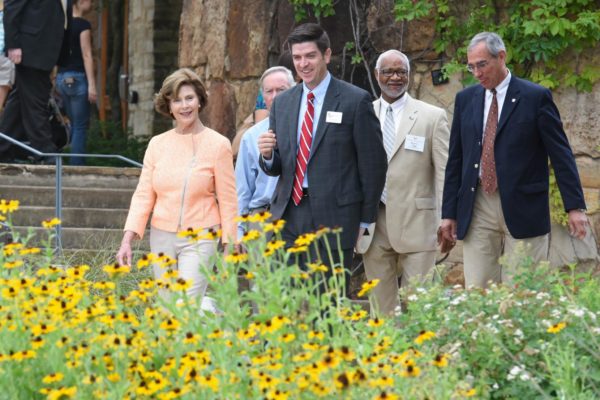“As everyone here knows the monarch butterfly is the most iconic and beloved insect in the world,” said former first lady and UT Austin alumna Laura Bush in her keynote at the South-Central Monarch Symposium this Wednesday. “But sadly, there has been an 80 percent decline in the monarchs’ eastern population.”
Held at UT Austin’s internationally recognized botanical garden and plant conservation center, the Lady Bird Johnson Wildflower Center, this symposium brought together scientists, experts and leaders from many prominent organizations to share best practices for helping the disappearing monarchs.
In her speech, the former first lady called for everyone from homeowners to big corporations to join together to help save the state insect of Texas.

There are many challenges to monarch recovery, but one of the greatest is installing quality monarch habitat along their migration route through Texas. Planting and preserving abundant milkweed and nectar plants across the state is required for monarchs to thrive. The help of private landowners and urban dwellers is especially important.
The monarchs migrate thousands of miles between Mexico and Canada, passing through Texas. During this astonishingly long journey, they need places to rest and eat.
Texans who want to help power the migration can put their yards and patios to work to save the monarchs. Experts at the Wildflower Center say choosing the right plants can make a big difference.
Click here for tips on planning a Butterfly Garden at your home or workplace.
Texans can power the migration by taking any one of these three steps:
- Planting or protecting native milkweeds.
- Planting or protecting nectar-rich wildflowers that bloom in spring.
- Planting or protecting nectar-rich wildflowers that bloom in fall.
Learn more from the Wildflower Center about the milkweed and nectar plants monarchs like most.
The goal is to increase the monarch population to 225 million by 2020.
“We think there are about 150 million monarchs flying today. So, the goal is ambitious, representing a 50 percent increase in the current population,” says the former first lady.
Texan by Nature, a group founded by Bush, is partnering with organizations, experts and landowners as one of their key initiatives. They are helping to develop a collaborative conservation framework for creating sustainable habitats for the monarch butterfly in Texas.
“The beautiful monarch butterfly is a symbol of hope from Mexico to Canada. It unites us as a conservation community. Homeowners, ranchers, foresters, schools, parks and corporate complexes,” she said. “The choices we make now will shape the future for the next generation.”
Bush believes we need to follow the science and connect people from all walks of life if the monarch is going to survive.




